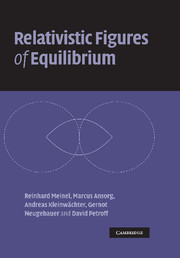Book contents
- Frontmatter
- Contents
- Preface
- Notation
- 1 Rotating fluid bodies in equilibrium: fundamental notions and equations
- 2 Analytical treatment of limiting cases
- 3 Numerical treatment of the general case
- 4 Remarks on stability and astrophysical relevance
- Appendix 1 A detailed look at the mass-shedding limit
- Appendix 2 Theta functions: definitions and relations
- Appendix 3 Multipole moments of the rotating disc of dust
- Appendix 4 The disc solution as a Bäcklund limit
- References
- Index
Appendix 2 - Theta functions: definitions and relations
Published online by Cambridge University Press: 22 October 2009
- Frontmatter
- Contents
- Preface
- Notation
- 1 Rotating fluid bodies in equilibrium: fundamental notions and equations
- 2 Analytical treatment of limiting cases
- 3 Numerical treatment of the general case
- 4 Remarks on stability and astrophysical relevance
- Appendix 1 A detailed look at the mass-shedding limit
- Appendix 2 Theta functions: definitions and relations
- Appendix 3 Multipole moments of the rotating disc of dust
- Appendix 4 The disc solution as a Bäcklund limit
- References
- Index
Summary
In this appendix we provide some basic definitions and relations for functions that play an important role in Section 2.3.
We shall not provide the related mathematical theory nor discuss theta functions in generality here. Starting from the (usual) theta functions, which were introduced by Jacobi, we follow the path taken by Rosenhain and define hyperelliptic theta functions of two variables, sometimes called ‘ultra-elliptic theta functions’ (Rosenhain 1850). Moreover, we list some useful relations between theta functions of each type. Besides the definition of the well-known elliptic integrals of the first and second kinds and the Jacobian elliptic functions, we include two less well-known functions, which can be constructed from elliptic integrals, namely Heuman's lambda function and Jacobi's zeta function. Furthermore, the relations between the Jacobian theta functions and the Jacobian elliptic functions that are important for our purpose in Subsection 2.3.3 are given. Finally, we list derivatives for some of the above functions that were used in Subsection 2.3.4.
Note that the notation in the literature (especially concerning theta functions) is not standardized. Throughout this book we comply strictly with the definitions presented here.
- Type
- Chapter
- Information
- Relativistic Figures of Equilibrium , pp. 187 - 192Publisher: Cambridge University PressPrint publication year: 2008



